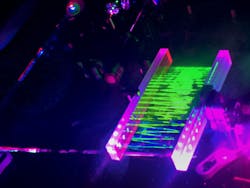Coded light sheets improve fluorescence volume imaging
Despite the fact that living beings are three-dimensional, microscopes inherently image two-dimensional planes. Z-scanning, confocal, and two-photon methods produce 3D output—and also introduce cost and complexity.
Light-sheet fluorescence microscopy (LSFM) illuminates a plane of the object perpendicular to the imaging objective, but mechanisms to scan the light sheet can be complicated, and high illumination intensity tends to photobleach specimens. Those issues are addressed in a new approach, coded light-sheet array microscopy (CLAM), developed by a research team coordinated at the University of Hong Kong.
Incoherent volume illumination
In standard LSFM, a laser source is conditioned to create a sheet of illumination significantly thinner than the sample thickness. Fluorophores within the light sheet are excited; those outside the sheet remain dark. The microscope objective collects light in the direction normal to the plane of the light sheet. The light sheet scans through the sample, collecting images at each plane and generating a 3D model. Scanning is performed by one of a few different varieties of mechanical system, but they all add significant amounts of time to the acquisition process. Attempts to simultaneously illuminate multiple planes are limited by speckle due to interference from the separate coherent light sheets; in addition, the beam-shaping optics are complex.
The new approach is conceptually straightforward. Divide one light source into a large number of virtual light sources, each incoherent with respect to the other. Condition each virtual source to create a single light sheet—that is, focus each through a cylindrical lens to create a quasi-uniform thin sheet through the sample. Impress a decipherable unique code on each of those light sheets. Simultaneously illuminate the entire sample volume with this set of thin sheets, so a single image acquisition recovers a depth-coded image of the entire depth of field.
The concept is easy to visualize, but the challenge was to make the implementation just as easy. The researchers found inspiration in about the simplest possible optical system: an “infinity mirror,” a pair of flat mirrors with a small relative tilt. Yuxuan Ren, a postdoc at the University of Hong Kong, described how a laser beam with a finite divergence is injected into the mirror pair, “where it will zig-zag inside the pair of mirrors.” A segment of the initial ray bundle will reflect “until the incidence angle on one of the mirrors is normal, then the beamlet is back-reflected following the same path.” Another portion of the beam centered around a slightly different angle will go through an additional two reflections before it reaches normal incidence. In this way, a set of beamlets are created from the single incident beam, with a large-enough difference in path length between adjacent beamlets to ensure they are mutually incoherent.
Coding light sheets
The next step is the impression of a unique code onto each of the light sheets; here again, the developers found inspiration in simplicity. Relay optics focus each of the beamlets onto a single line. They insert a rotating reticle mask at that conjugate plane, with the focused beamlets on a radius of the reticle. A pattern on the reticle impresses a unique modulation frequency on each beamlet. The combination of the beamlet spacing, the mask design, and the rotation speed of the reticle ensures that the codes for each of the light sheets are orthogonal for a given integration time. The spatially separated—and now temporally modulated—beams are focused by a cylindrical lens, creating parallel light sheets (see figure).
As in other LSFM realizations, the objective collects light along the axis normal to the light sheet plane, but in this case each pixel simultaneously collects light from every light sheet. The acquisition time is matched to the modulation frequencies of the light sheets to ensure that pixel-by-pixel Fourier decomposition can separate out each of the orthogonal frequency components.
CLAM is inherently reconfigurable: the number of light sheets, their spacing, their time delay, and their frequencies are adjustable, limited only by the camera frame rate. To demonstrate the method’s versatility, Tsia’s team imaged a branching blood vessel, a nanoparticle-impregnated tissue phantom, bead flow through a microfluidic channel, and a tissue-cleared section of mouse anatomy. According to Ren, “real imaging applications require flexible and reconfigurable fields of view,” so they configured the system with 13, 24, 27, 34, or 40 light sheets, with imaging rates up to 13 volumes/s. Because light from each depth plane is collected for the entire acquisition time, the intensity is low enough to avoid photobleaching without compromising signal-to-noise ratio (SNR). The mutual incoherence of the illumination planes also ensures the SNR is not reduced by speckle.
Tsia believes this flexibility suits the CLAM technique for “both the long-term monitoring required for developmental biology research and whole-brain imaging to advance neuroscience.”
About the Author
Richard Gaughan
Contributing Writer, BioOptics World
Richard Gaughan is the Owner of Mountain Optical Systems and a contributing writer for BioOptics World.

